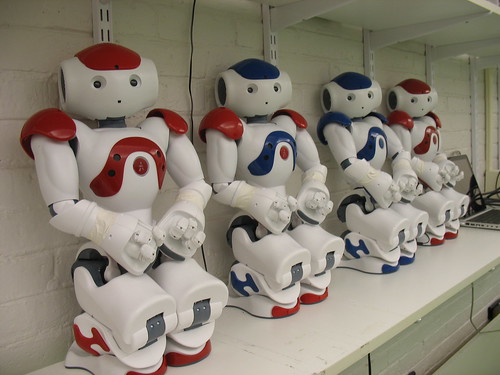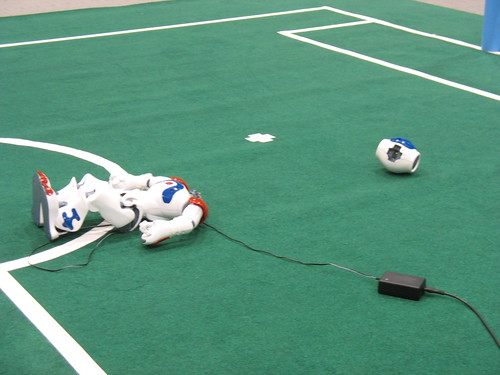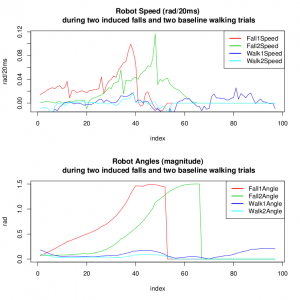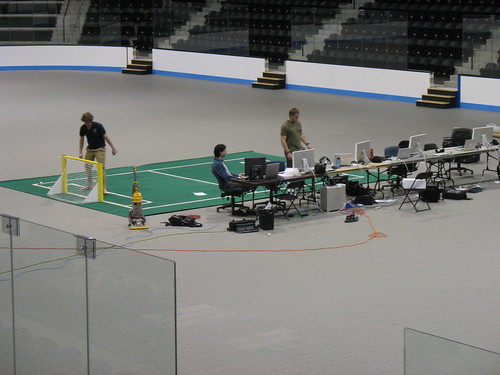In never before seen footage, the Northern Bites have unearthed the legendary evolution of the Nao robot. Don’t forget to check us out next week, as we travel to Graz, Austria, to compete in RoboCup 2009.
Author Archives: Joho
Inverse Kinematics Optimizations By Fixing the Joint Order
Embarrassingly enough, the code we use to position the robots limbs hasn’t been updated since we’ve actually had robots (which is more than a year), and thus still has two of the hip joints out of order in the kinematic chain ‘model’. When we got the physical robots, we just switched the order of the joints as they were generated by the inverse kinematics system and were done with it. (The rotations of the two joints are centered at the same point, so it doesn’t matter for small angles like during walking) Partly as an exercise, and partly to fix this longstanding inconsistency I just spent some time slogging through the old Mathematica notebooks and corrected the bug. What I wasn’t expecting was to see a speedup of almost 3 times with the new joint order! A series of 10000 calls to inverse kinematics(IK) on several different targets, using both legs took .30 seconds using the old kinematic models, and only .12 seconds with the new models (on my dev. machine). Even with the slow older models, IK took only a very small fraction of our runtime, so this unfortunately won’t result in a huge boost to our frame rate on the robots, but nonetheless its still pretty neat. See after the break for my explanation.
Continue reading
Controller preview graph
One of the main things I am working on for Austria is improving the responsiveness of the walk engine george and I wrote so that we can react quicker to changes in the balls location, etc. On the four legged Aibos, we could stop nearly instantly – on the Nao, we need to look ahead at our future plans a certain amount so that we can be ready to follow them when the time comes. The following is a graph of how our center of mass trajectory is affected during walking when we lower how far into the future we preview. As the preview period gets lowered, the curves become less and less ideal. The Cyan curves are the ones with the longest preview period:preview-period
Marvin is back from the shop
Headless Nao
We’ve posted some pictures of the venue on flickr (click through the image above). Some robot frames will be posted sometime soon for interested teams to look at (if you want to go through the trouble of reading our frame format).
Tomorrow we’ve got one more day of development before we pack up our things and head back to the lab.
Fall detection using angleX and angleY
Moving into Watson Arena for the Weekend
First Nao Goal
Using the first draft of our open loop walk, Marvin scored the first goal for any Nao in our lab! With competitions fast approaching, we are planning on taking advantage of our upcoming spring break to whip our robots into shape. On the menu: adding sensor feedback to close the loop on the walk, porting to NaoQi 1.2, tuning localization, and starting to work on positioning.
The open loop walk showed in the video still has a tendency to build up harmonic oscillations and tip over, but with a little support, and a brand new behavior, the robot is able to push the ball into the goal.
Bowdoin to host US OPEN SPL May 2nd – 3rd
We are proud to be hosting the US OPEN for the Standard Platform League this year. The event will be held in Bowdoin’s brand-new Watson hockey arena on May 2nd and 3rd. Currently we expect attendance from all the US Teams: CMU, UPenn, UT Austin and of course the Northern Bites.
We are excited to be the first non-hockey or athletics related event host in this venue. The venue has great lighting, a superb sound system, and also the built-in capability to do webcasting. We expect the venue to be open to the public from 9 to 5 both Saturday and Sunday. The finals will be held Sunday afternoon.
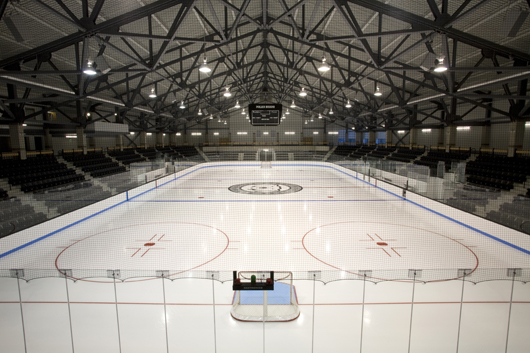
Interior of Watson Arena
First Nao V3 in our lab
Over break we got one of our robots upgraded in Paris to the new V3 model which is more robust and sports a second camera. I’ve posted a short video of it’s status message here.
Next week I’m going to Paris for a RoboCup workshop at Aldebaran to get the remaining three of our robots upgraded as well.
